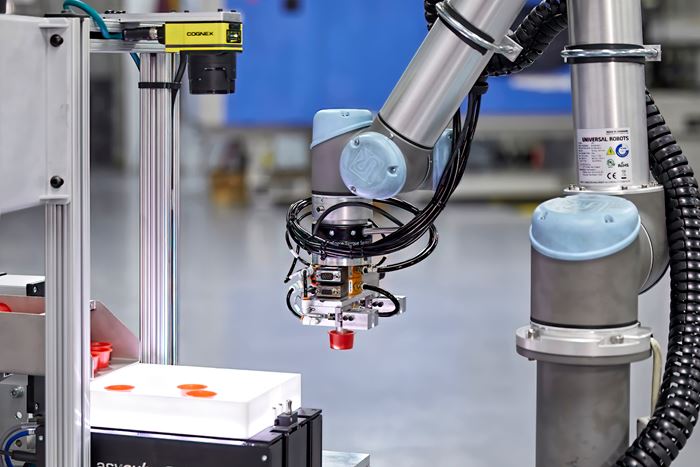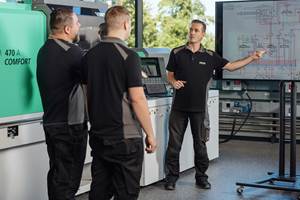‘Cobot’ Molding Assistants Take on New Challenges
They’re not just for packing boxes anymore. Collaborative robots are proving themselves capable of more sophisticated machine-tending tasks.
“Cobots have given us an advantage in efficient and safe work environments,” says Jason Glanzer, automation engineer at EVCO Plastics in DeForest, Wis. Short and sweet, that’s the basic proposition behind the new generation of collaborative robots—or cobots—that are proving increasingly popular with plastics molders. They can perform repetitive pick-and-place tasks that free up human workers for more sophisticated jobs. The “collaborative” label refers to cobots’ ability—in some circumstances—to operate in close proximity to humans without “hard” guarding enclosures.
First-generation cobots proved themselves apt at parts handling and stacking/packing applications. But as the cobots themselves improved, plastics users have tried them out in increasingly challenging applications.
A case in point is EVCO Plastics, a large custom injection molder with nine plants in three countries. For over a year, EVCO has been using articulated-arm cobots from Universal Robots at two plants in DeForest and one in Georgia. The company currently has six UR cobots, a number Glanzer says is bound to grow.
He says EVCO has applied cobots in concert with standard six-axis or Cartesian robots in several molding cells. In one cell molding plumbing fixtures, the cobot picks up an insert and places it on a fixture that is inside 5-ft-tall guarding around a six-axis robot. The robot takes the insert from the fixture and places it in the mold. “Previously, a person put the insert in the fixture and pushed a button to activate the six-axis robot,” says Glanzer.
In other applications, Cartesian robots demold parts and place them on a guarded conveyor. A cobot picks up parts from the conveyor and places them in a box using a programmed placement pattern and multiple layers. The cobot also places cardboard sheets between layers of parts in the box.
UR cobots are also used in assembly. “Universal Robots recently came out with force/torque sensors that mimic human actions better in multiple dimensions,” says Glanzer. For example, in one cell producing lawn/garden equipment gearboxes, “hard” automation assembles the components and hands the assembly off to the cobot, which fills it with grease, weighs it afterwards, and places a cap on it to seal the grease port. “Human operators were prone to forget a step, like weighing the assembly after grease filling,” notes Glanzer. This cobot uses machine vision to pick up the caps from a vibratory feeder.
As reported in a January article, EVCO also uses cobots to service a “printer farm” of 3D printers.
A number of EVCO’s cobots are mounted on casters so they can be wheeled to different presses to perform different pre-programmed routines stored in the controller’s memory. Ease of programming is important to EVCO, which uses the cobots in plants with short runs (24 to 40 hr) and frequent changeovers. Glanzer appreciates the cobots’ lead-through teach programming, using as few as four positions as “anchor” points, whereas conventional robots require more elaborate programming of more numerous points.
Glanzer also appreciates the cobots’ ability to work (in appropriate circumstances) without guarding. “With standard robots, all the guarding, safety relays, and light curtains can add thousands of dollars to the cost.” However, he notes that “soft” opto-electronic guarding can add “collaborative” quality to standard robots. One Cartesian robot that’s paired with a cobot has no enclosure around either one. A laser scanner detects a human intrusion into the operating space and slows or pauses the robot until the person moves away, when the robot resumes operation automatically.
Related Content
A Cost Saving Modular Approach to Resin Drying Automation
Whether implementing a moisture-sensing closed-loop system for a single dryer, or automating an entire plant, technology is available to take the guesswork and worry out of resin drying. Using a modular approach allows processors to start simple and build more capabilities over time.
Read MoreFive Ways to Increase Productivity for Injection Molders
Faster setups, automation tools and proper training and support can go a long way.
Read More50 Years...600 Issues...and Still Counting
Matt Naitove marks his first half-century in plastics reporting, with a few of his favorite headlines.
Read MoreProcessing Megatrends Drive New Product Developments at NPE2024
It’s all about sustainability and the circular economy, and it will be on display in Orlando across all the major processes. But there will be plenty to see in automation, AI and machine learning as well.
Read MoreRead Next
Understanding Melting in Single-Screw Extruders
You can better visualize the melting process by “flipping” the observation point so that the barrel appears to be turning clockwise around a stationary screw.
Read MoreAdvanced Recycling: Beyond Pyrolysis
Consumer-product brand owners increasingly see advanced chemical recycling as a necessary complement to mechanical recycling if they are to meet ambitious goals for a circular economy in the next decade. Dozens of technology providers are developing new technologies to overcome the limitations of existing pyrolysis methods and to commercialize various alternative approaches to chemical recycling of plastics.
Read More



























